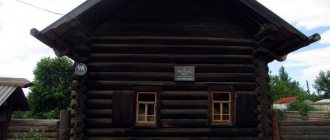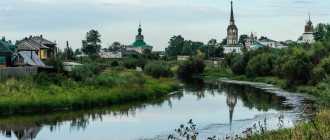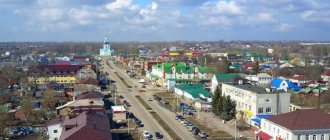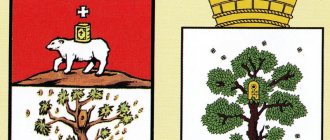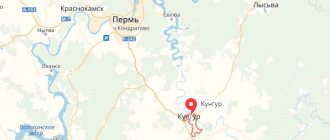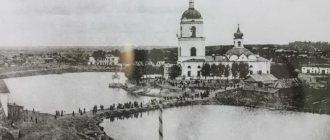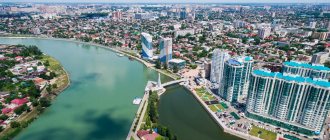This article is dedicated to the city of Tchaikovsky, in which I have lived for 35 years; this city is located in the Perm region. Today I will tell you about its location, introduce you to the sights of the city, and, of course, show a photo of the city of Tchaikovsky.
In the distant 80s, traveling on the ship “Alexander Fadeev” from Perm to Moscow, I visited here for the first time. The ship stayed here for only 2 hours, but I managed to fall in love with this green, calm town.
A tour of the streets, an excursion to the KShT (silk fabric factory), which was then famous throughout the country for its fabrics, friendly people - all this made a great impression on me, and then I thought: “I wish I could live in this city!”
Dreams come true if you really want it. In 1985, my husband’s parents were transferred to these parts to work in a rafting raid. And literally a year later, good news arrived: a place in his specialty was found in the same rafting raid for my husband, and our family is moving there. In this note I will tell you about the location of the city, introduce you to the sights, and, of course, show photos.
Where is the city of Tchaikovsky, Perm Territory?
The city of Tchaikovsky is located on the banks of the beautiful Kama River, along which ships carrying tourists pass.
Where is Tchaikovsky located? This is the former village of Saigatka, and it is located on the left bank of the Kama River. The terrain here is flat, there are no mountains. Tchaikovsky belongs to the Perm region and is a regional center.
You can get to our places by road from Perm (a road about 300 km long) and from Izhevsk (about 100 km). Buses from the bus stations of these cities run regularly on schedule, so you can choose the time when you need to get to the nearest airports in Perm or Izhevsk.
Many people prefer to use taxi services, it’s faster, but at a higher price, for example: a bus ticket to Izhevsk costs 240-260 rubles, and a taxi fare costs 1100-1300 rubles.
30 years ago it was easy to get to our region by water on small ships that sailed on a schedule, which was very convenient for passengers; it was a good and cheap form of transport.
There is a railway line here and is located at the Saygatka station, but only one passenger carriage runs along it once a day to Izhevsk. The railway is mainly used for cargo transportation, this is due to the fact that the station is a dead end.
But the convenient location of the Kauchuk station, 20 km from the city, made it possible to create the “Tchaikovsky Dry Port” here. “Dry Port Tchaikovsky” is a cargo terminal, that is, a large area for storing cargo in containers for further shipment to distant regions, as well as to the ports of the Far East.
A ready-made logistics base, as well as an advantageous location literally on the border of four regions: Perm Territory, Bashkiria, Tatarstan and Udmurtia, will allow us to quickly solve the problem of reducing the cost of transporting goods from nearby regions.
Increasing the terminal's capacity will lead in the future to the ability to deliver cargo to Europe, Kazakhstan, China, Southeast Asia and back. The base is growing and developing: it has 4 tracks with a capacity of 71 conditional cars on each track.
A site of 10 thousand square meters was built for working with containers, and a reach stacker was also purchased, that is, a loader with a lifting capacity of 45 tons. Thanks to this, a cargo turnover of 2 million tons has been achieved at the Kauchuk station, and this is not the limit.
Saiga
Everything has been preserved to the smallest detail, wooden household items, spinning wheels, a device for ironing clothes, rolling pins, boards, and other unknown attributes of the life of peasants of the 18th century, which the girl guide told us about interestingly. The estate is designed in such a way that it seems that peasants lost in history live there to this day; they simply went away for a while to harvest or do other work in the fields; the guide took advantage of their temporary absence and decided to tell people how it was.
History of the city Tchaikovsky
Tchaikovsky grew up from the working-class village of Saygatka. People here have been engaged in crafts and working on the land since ancient times. The village of Saigatka in the 18th century was even involved in the historical “Pugachev” events: on its outskirts there was a battle with rebels.
In Soviet times, when the fourth five-year plan was approaching, our country issued decrees that stimulated the construction of hydroelectric power stations throughout the country. It was the post-war period, when the country was in a difficult economic situation, and it was necessary to look for ways to boost the national economy.
The operating principle of hydroelectric power plants is based on the use of water energy. The cost of electricity was much cheaper than from thermal stations. The leadership of the Perm region carried out intensive work to find places for the construction of hydroelectric power stations. The village of Saigatka was located on the banks of the deep Kama River, and this contributed to the choice of the construction site.
History of the city and construction of the Votkinsk hydroelectric power station
Photo about the construction of the Votkinsk hydroelectric power station.
In 1955, near the village of Saigatka, they began to build the Votkinsk hydroelectric power station. Construction lasted 10 years, and in the summer of 1965 the Votkinsk hydroelectric power station was put into operation.
During construction, the height of the water in the Kama River increased by 23 meters. This led to the formation of the Votkinsk reservoir. Nearby forests and several villages were flooded; next to the hydroelectric power station there is a shipping lock, which, like a traffic controller, allows ships through.
The construction of the hydroelectric power station gave impetus to the rapid growth of the population of the selected village, and already in 1962 the village received city status. The name of which was given in honor of the great Russian composer Pyotr Ilyich Tchaikovsky, whose homeland is very close, 30 km away, in the city of Votkinsk.
In the 60s, rapid construction began: schools, a hospital, and an airport appeared. The following districts appeared: Prikamsky, Osnovnoy, Zavyalovsky, and the villages of Zarinsky and Zavokzalny were formed later.
The rapidly growing population needed somewhere to work, so a silk fabric factory was built, as well as a meat processing plant to supply the population with meat products. For your information: at that time, the meat processing plant produced more than 100 types of meat products, and there was even enough of it to supply it to other regions.
In the 60s, a dairy plant, a river station, a river port with a ship repair base (electronic warfare of the fleet), as well as a water utility department were built. During the heyday of the national economy, rafting raids operated throughout the country, transporting timber along the rivers. There was a lot of construction going on in the country, and timber was needed. Transporting timber by water was the cheapest mode of transport.
Previously, wood needed for construction purposes was floated along the Kama River.
A rafting raid also appeared in the city in 1964. Due to the nature of my education (forestry and timber industry engineer), I am familiar with working in rafting raids. We, young girls, were sent to help the brigades at the raft. This is the kind of work when men tied logs in a raft with the help of spikes and ties, and we used hooks to “drive away”, push away the logs that floated too close to our raft. It was interesting but dangerous work.
Development and growth of the city in the 70-80s
Subsequently, such enterprises as the Stroydetal plant, the Repair and Mechanical Plant, the Synthetic Rubber plant, where rubber products were produced, and the Chaikovskaya Thermal Power Plant grew up. Work at these enterprises was prestigious, and young specialists were happy to come here and get a job.
The Precision Engineering plant, which was put into operation in the 70s, produced vacuum equipment and machine tools, but existed only until the 90s, then it was liquidated - it could not withstand the crisis.
In the 80s, the Permtransgaz enterprise was founded, which controlled gas transportation throughout the Perm region and Udmurtia. Now this enterprise is called Gazprom Transgaz Tchaikovsky LLC, and it plays a big role in the economy of the region. They supply gas to neighboring countries and to the center of Russia. The entire Western Urals uses its blue fuel.
Tchaikovsky: population and employment
Young people can get an education without leaving far from home.
The population of the city is a little more than eighty-three thousand people, and together with the administrative district - one hundred and four thousand people. The population has the opportunity to study and improve their level of education.
In the city of youth there is where to get higher education, this is the Branch of Izhevsk State University. M.T. Kalashnikov, Tchaikovsky State Institute of Physical Culture, Branch of Perm State Technical University.
After 9th grade, young people can enter colleges: industrial, industrial-humanitarian, medical, as well as the technical school of industrial technologies, vocational school No. 92.
The music school is located on Lenin Street. The large assembly hall now hosts performances and performances due to the renovation of the drama theater building.
For musically gifted children there is a music school and an art school. There are many students in our city. It's nice to walk around the city and meet smiling girls and young men. Where there is youth, there is a future. Many guys find work in city enterprises.
Among the large enterprises that remain are the above-described Gazprom Transgaz Tchaikovsky LLC, RusHydro OJSC - Votkinskaya HPP, a gas equipment plant, Tchaikovskaya CHPP-18, Neftegazdetal LLC, and in the suburbs near the village. Foki is a brick factory. Many people work in the service sector, in cargo transportation, and also on a rotational basis at enterprises in the northern regions of the country.
I would like to note that it has undergone great changes: since 2012, a project has been implemented to modernize production to increase production volumes, product quality and expand the range of uniforms for law enforcement agencies and workwear for enterprises. And the “Lyceum” fabric for school clothes was included in the golden hundred of the best goods in Russia. The Tchaikovsky Textiles enterprise was awarded medals and diplomas for high-quality products.
Exemplary choreographic ensemble Mosaic
File:YwGVcj7iDIg.jpg The exemplary choreographic ensemble Mosaic was founded on the basis of the choreographic department of Children's Art School No. 1 in the city of Tchaikovsky in 1990. The founder and director of the ensemble is Olga Borisovna Zakharova. The ensemble consists of junior, middle and senior groups. After graduating from art school, most children remain in the ensemble, in the older age group. Every year the number of ensemble members increases. The Mosaic ensemble is an integral decoration of both city and regional events. The ensemble is a regular participant in sporting events taking place in the city of Tchaikovsky. These are events such as the Continental Ski Jumping Cup (2012), the Russian Nordic Combined Championship (2012), the Russian Summer Biathlon Championship (2012), the Russian Sports Tourism Cup (2013) and many others. . File:-QXT1JlVNqQ.jpg
The ensemble employs teachers with higher choreographic education.
A positive microclimate has been created in the ensemble; children know how to build interpersonal relationships. The ensemble teaches children independence and responsibility for their actions. File:F39JmYFggW8.jpg
Many graduates of the ensemble continue their studies at the best universities in the country and, after completing their studies, return as teachers to their native ensemble. Every year, in May, the ensemble’s reporting concert is held, where all the fruits of the painstaking work of the entire team are demonstrated.
File:JK-xn1r6tQk.jpg In 2006, an ensemble of drummers and majorettes was created on the basis of the group. The head was the teacher of Children's Art School No. 1, Alexander Petrovich Tsygulev. It included participants from the older age group.
Now the ensemble of drummers Mozaika is the brightest representative of this trend in the entire Perm region.
Choreography
International competition of folk stage dance in Orel - 1st degree laureates (2009, 2011) All-Russian competition of ensembles and choreographic groups in Yaroslavl - 2nd degree laureates (2010) Interregional folk dance festival "Ural Evening" - 2nd degree laureates ( 2010) Regional competition “Crystal Slipper”, Perm - 1st degree laureates (2009, 2010, 2012) All-Russian competition “Native Land” - first degree laureates (2013) All-Russian festival-competition “Baltic Breeze” St. Petersburg – 1st degree laureates (2013) All-Russian competition named after. V. Spivakova, Nizhny Novgorod – 1st degree laureates (2013)
Drums
All-Russian festival-competition of ceremonial culture, drummers and majorettes “Prikamsky Stars” - 1st degree diploma winners (2010), Grand Prix winner (2011, 2012) Festival “White Nights” Perm (2013)
Categories: Registration Login Login via VK Login via FB Login via Google Login via Yandex
Where can you go in Tchaikovsky
People who come on business trips or to receive treatment at our sanatoriums can visit clubs, discos, dating evenings, numerous cafes and restaurants in the evenings. And for those who are tired of just sitting in cafes and restaurants, they type in the search for what they can see, and from the photos of the city they navigate where to go.
These days, our beloved city has changed a lot. It has become even more beautiful, greener, and is surrounded on three sides by the water of the Kama River, the Votkinsk Reservoir and the bay of the Saigatka River.
On the beautiful embankment, which starts behind the Elegant service house and stretches all the way to the beach, you can walk in summer and winter, enjoying the peace of the water. In the summer, river regattas, beach volleyball competitions, and various entertainment events for adults and children take place here.
The embankment is currently being improved. Its width is increased to 10 meters, a bicycle path, recreation areas are being laid, art objects and much more will be installed.
The central entrance to the embankment will be made near the Glory Memorial, where the obsolete parts of the Memorial and granite slabs were also reconstructed.
Interesting places for tourists
The Glory Memorial on Lenin Street was restored this year.
Tourists arriving on excursion ships love to visit the Glory Memorial on Victory Square. It was erected in memory of fellow countrymen who did not return from the Patriotic War. Near the stele with the Order of Victory at the top there is an eternal flame, there are always a lot of flowers, and every year on May 9 a rally is held here in honor of the Victory in the Second World War.
Further along Lenin Street there is a beautiful park. In 2011, it was reconstructed: paved with paving slabs, trees and shrubs were planted, a flower bed was laid out, and beautiful benches were installed for citizens to relax.
The central square is also a favorite recreation spot for adults and children. After 20-00 hours in the summer there is a musical fountain and wonderful music sounds. Music festivals are also held here, where residents gather with pleasure to watch performances by artists. In winter, a Christmas tree, ice figures and slides for children are installed in the central square.
Tchaikovsky Park of Culture and Leisure
You can relax in Tchaikovsky Park both in summer and winter.
But the most favorite vacation spot for citizens is, of course, the city park. It was reconstructed and put in order. Mass events and entertainment for various holidays are constantly held here. Attractions in the park begin to operate in May, when it gets warm. Prices for attractions are very affordable: 100-150 rubles. There is also a cafe where vacationers can have a snack.
Cleanliness and order in the park are maintained both by the park workers themselves and by the concerned public. People come to cleanup days on their own initiative and clean the paths in the park, as well as the nearby forest right up to the pier. A small beach has formed next to the pier, so vacationers are interested in the cleanliness of the area and are not lazy to clean up trash after themselves and others.
In the summer, ships with tourists dock at the pier, music and laughter are heard. Here they sell dried and dried fish and various souvenirs from stalls, which is very fun and profitable.
Winter and summer competitions are organized at Snezhinka
View of one of the jumps on Snezhinka.
The Ural cities have always been famous for their love of sports: there is an Institute of Physical Culture and the Federal Training Center for Winter Sports “Snezhinka” named after A.A. Danilova.
Previously, it was just a ski base where students from the Institute of Physical Education trained, but now it is a complex built according to international standards. There are 5 jumps, ski slopes of varying difficulty, and a biathlon complex.
Federal has passed international certification and now accepts athletes from all over the world. In 2021, in the summer, the Biathlon World Championships were held here.
Holidays in Tchaikovsky Perm region: museums, galleries, theater
The drama theater is currently under renovation.
To preserve the historical and cultural heritage of the region in the city, enthusiasts, even during the construction of the Votkinsk hydroelectric power station, proposed organizing a local history museum.
A start had been made: they began collecting household items, recording the memories of old-timers, going to study and learn from museums in other cities in the region. And at the end of 1963, by decision of the city executive committee, the museum received official status.
The museum constantly hosts lectures and conversations, exhibitions, excursions for schoolchildren and adults, including excursions to the Peasant Estate Museum. Every visit to the museum keeps me in a good, joyful mood for a long time.
In the summer, various events with performances by folk groups are held near the peasant estate.
For example, having visited a doll exhibition, you cannot remain indifferent to such beauty, to such creativity of people! The author embroiders every stitch on the dolls' costumes with such love that sometimes you are amazed at such skill.
A few years after the creation of the museum, an art gallery was also organized. It has become a truly provincial museum, created with gifts from famous artists and collectors. The art gallery hosts various events: master classes, intellectual games, so you never get bored. The museum and gallery are open on weekdays from 10 a.m. to 5 p.m. at st. Mira, 21.
The population is not deprived of the attention of famous actors and singers who come to our city with concerts. We also have our own Drama and Comedy Theater. It is located on Vokzalnaya street, building 5a. Ticket price: in the evening – 200 rubles; in the morning – 150 rub. for all.
Site search
Our group in Telegram for the exchange of ideas, projects, thoughts, people in the IT field of Rostov-on-Don: @it_rostov Name of locality (city): Tchaikovsky
International name:
Chaykovskiy
Size of settlement:
District center or city with a population of more than 100 thousand people
District (district):
